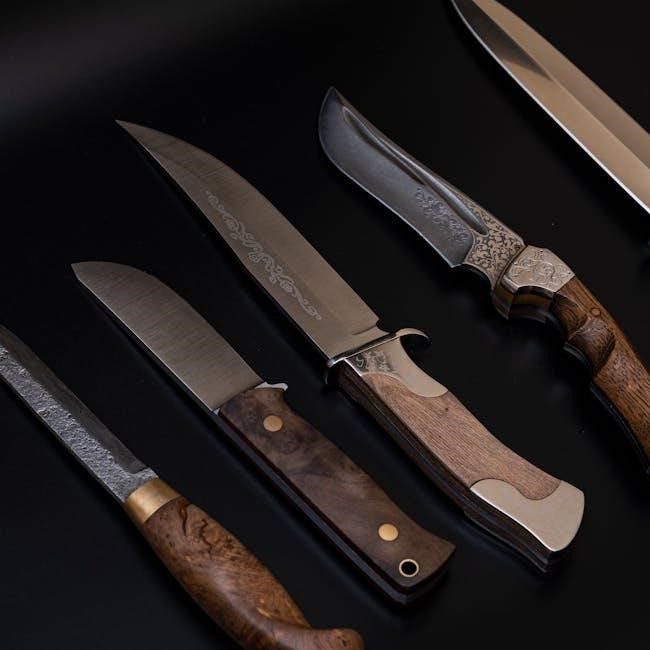A file guide is a must-have tool for knife makers, ensuring precision and consistency in grinding and shaping blades. It simplifies the process for professionals and beginners alike.
What is a File Guide?
A file guide is a precision tool designed to assist knife makers in grinding and shaping blades accurately. Typically made from hardened steel, it allows users to secure knife parts firmly and guide files along specific angles or surfaces. This tool is essential for maintaining consistency and achieving precise edges, making it a cornerstone in both professional and amateur knife-making processes.
Importance of a File Guide in Knife Making
A file guide is indispensable for achieving precision and consistency in knife making; It ensures accurate angles and even bevels, crucial for a sharp, durable blade. By maintaining precise control during grinding and sharpening, it reduces errors and enhances efficiency. This tool is particularly valuable for professionals and beginners alike, streamlining the process and elevating the quality of the final product. Its role in maintaining consistency makes it a vital asset for crafting both complex and everyday knives.
Components and Materials of a File Guide
A file guide typically consists of a hardened steel body, often made from high-carbon or tool steel like D2, ensuring durability and precision. It may include adjustable components for secure knife alignment and features for various grinding angles, making it versatile for different knife-making tasks.
Design and Construction of a File Guide
A file guide is precision-engineered to ensure stability and accuracy. It typically features a rigid, hardened steel frame with clamps or vices to secure the knife. The design includes alignment markers and adjustable stops, allowing for consistent grinding angles. Some models incorporate interchangeable components for versatility, catering to various knife styles. The construction prioritizes durability, with materials like high-carbon steel or D2 tool steel to withstand frequent use. Its compact, ergonomic design makes it easy to maneuver while maintaining control during the grinding process.
Materials Used for Making a File Guide
File guides are crafted from high-quality, durable materials to ensure longevity and precision. Hardened steel, often with a Rockwell hardness rating of 60 or higher, is commonly used for the main frame. Components like clamps and adjustment screws are typically made from stainless steel or titanium for corrosion resistance. Some advanced models incorporate carbide surfaces for added wear resistance. The selection of materials ensures the guide remains stable and maintains precise alignment during the grinding process, crucial for achieving consistent results in knife making.

How to Use a File Guide in Knife Making
Mastery of the file guide enhances knife-making efficiency. Secure the knife, align the guide, and maintain consistent angles while grinding for precise results every time.
Step-by-Step Guide to Using a File Guide
Begin by securing your knife firmly in the file guide, ensuring the blade is held tightly. Align the guide with the desired edge angle. Hold the file at the correct angle and gently draw it along the blade, maintaining consistent pressure. Repeat this process, flipping the knife as needed to achieve uniformity. Regular use of the guide ensures precise edges and a professional finish, making it an indispensable tool for knife makers.
Common Techniques for Grinding and Shaping
Knife makers often use file guides to achieve precise edge profiling and beveling. A common technique involves maintaining consistent file strokes along the blade’s length. For straight edges, the guide ensures even contact, while angled edges benefit from careful alignment. Regularly checking the blade’s progress and adjusting the guide as needed helps maintain accuracy. These methods ensure uniformity and precision, making the file guide indispensable for both professionals and beginners in knife crafting.

Types of File Guides for Knife Makers
Knife makers use standard file guides for basic grinding and shaping. Specialized guides offer custom features like adjustable stops for intricate designs and precision work.
Standard File Guides
A standard file guide is a fundamental tool for knife makers, designed to ensure precision and consistency in grinding and shaping blades. Typically made from hardened steel, it provides a stable surface for filing, allowing precise control over edge geometry. This tool is particularly useful for maintaining consistent angles and straight edges, crucial for achieving professional-quality results. Its simplicity and durability make it a fundamental asset in every knife maker’s workshop, suitable for various tasks and blade types.
Specialized and Custom File Guides
Specialized and custom file guides cater to specific needs, offering tailored solutions for unique knife-making projects. These guides are often designed with advanced features such as adjustable stops, multiple angle settings, or customizable surfaces. Crafted from high-quality materials like D2 tool steel, they provide exceptional durability and precision. Custom file guides are ideal for intricate designs or non-traditional blade shapes, allowing makers to achieve flawless results. They are a valuable investment for those seeking perfection in their craftsmanship.

Benefits of Using a File Guide
A file guide enhances precision, consistency, and efficiency in knife making. It ensures accurate angle maintenance, reduces errors, and speeds up the grinding process, making it a valuable tool for professionals and beginners alike.
Improved Precision and Consistency
A file guide significantly enhances precision and consistency in knife making by ensuring accurate angle maintenance and reducing errors. It helps maintain uniform bevels and symmetry, which are critical for a knife’s functionality and aesthetics. By providing a stable reference point, the file guide allows for precise control over the filing process, making it easier to achieve consistent results. This tool is particularly valuable for maintaining precise edge geometry and ensuring that the knife meets high-quality standards, whether for professional or hobbyist projects.
Efficiency in Grinding and Sharpening
A file guide enhances efficiency in grinding and sharpening by streamlining the process and reducing manual adjustments. Its hardened steel construction ensures durability and consistent results. By maintaining precise angles and alignment, it minimizes the need for repeated filings, saving time. This tool is especially beneficial for complex knife designs, allowing for smooth, even grinding. It accelerates the sharpening process, ensuring sharp, precise edges with minimal effort, making it indispensable for both professional and hobbyist knife makers aiming for high-quality finishes.

Choosing the Right File Guide
Selecting the right file guide involves considering materials, precision engineering, and durability. Look for hardened steel construction and high-strength designs to ensure stability and corrosion resistance, aiding knife makers in achieving optimal results efficiently.
Factors to Consider When Selecting a File Guide
When choosing a file guide, prioritize durability, precision engineering, and compatibility with your knife-making needs. Consider the type of steel used, as hardened steel ensures longevity. Evaluate the design for stability and alignment features to prevent movement during use. Custom or standard designs should match your specific requirements. Additionally, assess ease of use, ergonomic factors, and compatibility with various file types. Finally, research the manufacturer’s reputation and customer reviews to ensure quality and reliability for optimal knife-making results.
Tips for Buying or Making Your Own
When buying a file guide, research materials like hardened steel or D2 tool steel for durability. Read reviews to ensure precision engineering and compatibility with your knife-making needs. For DIY enthusiasts, consider crafting your own using high-quality materials and ensuring proper heat treatment for stability. Whether buying or making, prioritize alignment features and ease of use. Ensure compatibility with your workflow and ergonomic preferences for optimal performance in grinding and shaping knife blades effectively.

Maintenance and Care of a File Guide
Regularly clean your file guide with a wire brush and solvent to remove metal particles. Store it in a dry place to prevent rust. Inspect for wear and tear, replacing parts as needed to maintain accuracy and functionality over time.
Cleaning and Storing Your File Guide
Regular cleaning is essential for maintaining your file guide’s effectiveness. Use a stiff wire brush to remove metal shavings and debris. Apply a solvent like alcohol or mineral spirits to dissolve any residue. After cleaning, dry the guide thoroughly with a soft cloth to prevent rust. Store it in a protective case or pouch, away from moisture and direct sunlight, to ensure longevity and prevent corrosion. Proper storage and cleaning routines will maintain its precision and extend its lifespan.
Sharpening and Replacing Parts
To maintain your file guide’s precision, sharpen it regularly using a diamond stone or sharpening steel. Focus on the edges and surfaces that come into contact with the knife. Check for wear and tear, and sharpen when performance begins to decline, typically every few months with heavy use.
Replace damaged or worn parts immediately to avoid compromising your work. Refer to the manufacturer’s instructions for replacement procedures. Proper sharpening and timely part replacement ensure your file guide remains effective and extends its lifespan, keeping your knife-making projects precise and consistent.

Advanced Techniques and Tips
Master advanced knife-making techniques by refining edge geometry and using precision file guides. Sharpen with diamond stones and maintain tool flatness to prevent overheating during grinding.
Expert Tips for Mastering File Guide Usage
For mastering file guide usage, start by ensuring proper alignment and secure clamping of the knife. Use a marker to highlight the edge, allowing precise tracking. Maintain tool flatness by regularly sharpening and cleaning the guide. Apply consistent pressure to avoid uneven wear. Experiment with different file grits for finer finishes. Practice on scrap steel to refine techniques before working on final pieces. Regularly inspect and replace worn files to maintain accuracy and efficiency in your knife-making process.
Troubleshooting Common Issues
Common issues with file guides include misalignment and uneven wear. Ensure the guide is securely clamped to avoid shifting during use. If the edge becomes uneven, check the alignment and tighten the clamp. Regularly clean the guide to prevent debris buildup. Replace worn-out files promptly, as dull tools can damage the knife. For persistent problems, inspect the guide for damage or warping. Always use a marker to highlight the edge for better visibility during grinding. Proper maintenance ensures consistent results and extends the tool’s lifespan.